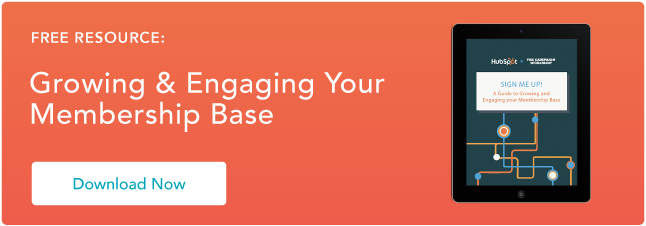
Like many other marketing strategies, inbound marketing transcends B2B, B2C, and nonprofit marketing. Inbound marketing isn't just about closing sales. It's about identifying and building trust with people in your target market. Its principles and tactics apply whether you're a business trying to acquire customers or an organization trying to acquire new members and inspiring a more engaged membership.
The first main principle of inbound marketing is that your marketing has to be all about your member (and potential members). It's not about you. It's a little bit about you, but in the sense that your organization needs to publish content and engage with your prospects and members on their terms. Talking to them about the what matters to them, and through the communication channels they prefer, establishes your organization as a trusted authority. Building on that relationship as a trusted authority is how you gain the credibility to inspire them to act later on.
It's so easy for people to screen phone calls, throw out snail mail, and ignore emails that don't stand out in their inboxes. The old strategies of sending out expensive, high-gloss reports or paying for on-air ad buys don't return the same number of prospects as inbound marketing. And let's not even get started on the fallacies of buying lists.
If you want to bring in new members and keep them active and inspired, delighted members who donate, volunteer, and spread the good word – your organization needs to align its marketing strategies and tactics to HubSpot's custom inbound methodology.
Using your content and offers to gently push prospects through each phase of the inbound methodology is the second main principle: Every marketing action your team takes, every piece of content it publishes – you should know exactly which persona is targeted, which phase they're currently in, and where you want them to go.
 As you can see, the inbound methodology has four distinct phases:
As you can see, the inbound methodology has four distinct phases:
- Attract: Gaining the attention of the right kind of people, people who fit your personas and align with your organization's mission.
- Connect: Encouraging those people to identify themselves to your organization as people interested in hearing more from you.
- Engage: Bringing people into the fold where they do more than consume your content, but become active members or donors.
- Inspire: Continuing to motivate action from prospect and members who've already "raised their hand," showing interest in your organization.
Let's take a closer look into the goals and common tactics used in each phase. For a more complete deep dive into each of these, take a look at our free guide, Growing and Engaging Your Membership Base.
Attracting Potential Members
The whole premise of inbound marketing is doing away with the interruptive marketing tactics of the past in favor of attracting your target audience to you. In the digital world, this requires publishing online content that your prospect can't resist in to attract traffic to your website.
Your starting point is specifying what kinds of information, causes, and concerns interest your potential members. Then determine what resources your organization has to meet those concerns. Are potential members most interested in professional development or business development? Networking? The answers to these questions shape what topics your write about, as well the keywords you focus on in your SEO strategy.
Blogging, paired with a relevant, targeted SEO strategy, is key to getting found in search results and driving traffic to your website. Your social media strategy, such as which sites you're on and how you interact with your audience there, is also part of the attracting step. You use your social media channels to promote your blog content and participate in relevant (hashtag) conversations, also driving traffic back to your website.
The attraction phase is all about driving those traffic numbers to your website, where you can then move these prospects into the next phase.
Forging Connections with Your People
Your attraction strategies are working. People are visiting your website and blog. Now you want to know who they are. You want them to identify themselves to you and subscribe to your email list. As you know, once you get their email address into your database, a whole new world of engagement opens up.
But first – you need to give them a good reason and opportunity to share their email with you.
In this inbound step, you want to offer some premium content that they can't resist. Your premium content could be a report providing in-depth analysis forecasting the future state of your industry, or access to expanded video content of a recent trip by members advocating for one of your group's policy positions. Asking them to sign up for your newsletter is also an effective option.
You pique their interest in your premium content through compelling calls-to-action (CTA) that you place on sign-up forms throughout your site or on landing pages exclusively dedicated to moving visitors to click that CTA and offer their email address to you.
Some of your website visitors will be ready to make a stronger commitment to your organization other than simply sharing an email. It may be their first visit to your website or their 100th. Either way, you want other CTAs providing them that opportunity. That's part of the next phase.
Engaging with Prospects so They Become Members
The engagement phase is where you start to grow your membership numbers, where you move people from email subscribers to active members.
Part of it is including the right action CTAs on your website. You'll always want a "Join Now" and "Donate Now" type CTA in the right spots on your website, but you can get creative with them. Say a major members-only event is coming up, you can update your membership CTA copy to reflect that. Has there been something major happened in the news, or perhaps it's time for your annual donation drive?
Of course the purpose of getting prospects into your database in the first place was so you could push out more content that interests and entices them. Email campaigns personalized to subscribers based on how they engage with your website, social media, and other emails, deepen their trust in your organization and strengthen that relationship.
Assessing their online behavior and level of engagement with your earlier content, you can determine when to send an email series that ends with a request for real action, whether becoming a member, making a donation, or volunteering.
Inspiring an Active Membership
The inbound process doesn't end when someone actively engages with your organization online. You want to keep them inspired, to continue donating and volunteering. To remain active members who will become some of your organization's best ambassadors as they share your content and work on and offline to their communities, attracting more people.
In order to inspire, you want to send them the content and CTAs that engage their hearts and souls, that evoke their emotions. As a tech-based methodology, inbound marketing provides a constant stream of digital intel you can gather about your members and prospects. What blog posts they read and share, which ones they ignore, and even what social media channels they engage with. This is all information you can use to personalize the content you send them, increasing the odds it will inspire them to stay engaged with you.
An integral part of being able to inspire your audience is staying on top of what's moving your prospects and members. So re-assessing your personas, conducting surveys, taking a meta-analysis of what kind of content performs well – these are all tactics that will help you continue to give your audience the content they seek and reinforce your organization's position as the trusted authority in your area.
from HubSpot Marketing Blog http://blog.hubspot.com/marketing/how-does-inbound-work-for-membership-marketing

No comments:
Post a Comment